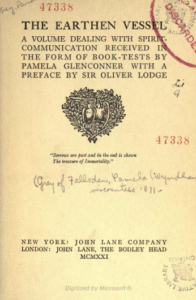Review
We have in this book, which gives an account of eighteen book-tests obtained by Lady Glenconner and nine by the Revd. Charles Drayton Thomas, at sittings with Mrs. Leonard, a valuable contribution to the literature of psychical research. The ostensible communicator of the tests is Edward Wyndham Tennant, a son of Lord and Lady Glenconner. Nearly all of the items are good, and some of a remarkably convincing character, as for instance the following:
Feda. ” Bim now wants to send a message to his Father. This book is particularly for his Father; underline that, he says. It is the ninth book. . . take the title, and look at p. 37.”
We found the ninth book on the shelf indicated was Trees, by J. Harvey Kelman. And on p. 36, quite at the bottom and leading on to p. 37, we read: ” Sometimes you will see curious marks in the wood; these are caused by a tunnelling beetle, very injurious to the trees. …“
The point is that in pre-war days forestry was Lord Glenconner’s chief interest, and it would have been a surprise to his family, when taking a walk with him, if he did not call attention to the ravages made by this particular insect. For aptness and precision the example would be hard to beat.
The precautions taken in identification of the books and passages are not set out with the particularity with which they are given in the Society’s publications, but it was hardly necessary, and there is no reason to doubt that all care was taken about this important detail of the experiments. The book is of great interest, and there can be little doubt that it will do much to awaken extended interest in the inquiry ; for the significance of these tests is much more easily grasped by the general public than is the case with cross-correspondences, the records of which, it must be admitted, are sometimes very hard reading.
It seems at first blush as though the book-tests, of which we have now a considerable number, made the evidence for survival much more convincing than it was before. Yet on the other hand it may be argued that the extraordinary clairvoyant power shown might possibly belong to the medium no less than to a discarnate spirit. It would be out of place to discuss this question here, but I will venture to remark that, while the possession of the power by a spirit after death is hardly less wonderful than its possession by one still in the flesh, the evidence at present seems to point to the “communicators” as authors of the tests far more strongly than to the medium. Some further light on the point might be obtained, if experiments were made to see whether a medium can produce similar successful book-tests without any suggestion from the sitter of a desire to communicate with a spirit, and without any claim by the medium to assistance from the spirit world. At the same time, it is notoriously difficult to keep out spirits who want to come in, and it might be difficult to prove in the case of a successful experiment of this kind that some spirit had not had a hand in the business after all. In past times Hotspur and others have been sceptical to the point of rudeness about the possibility of raising spirits ; it may prove that the difficulty is rather in “laying” them, and the Percies may yet have to vail to the Glendowers.
M. A. Bayfield
Journal of the Society for Psychical Research, vol. 20 (1921-22), pp. 107-8
